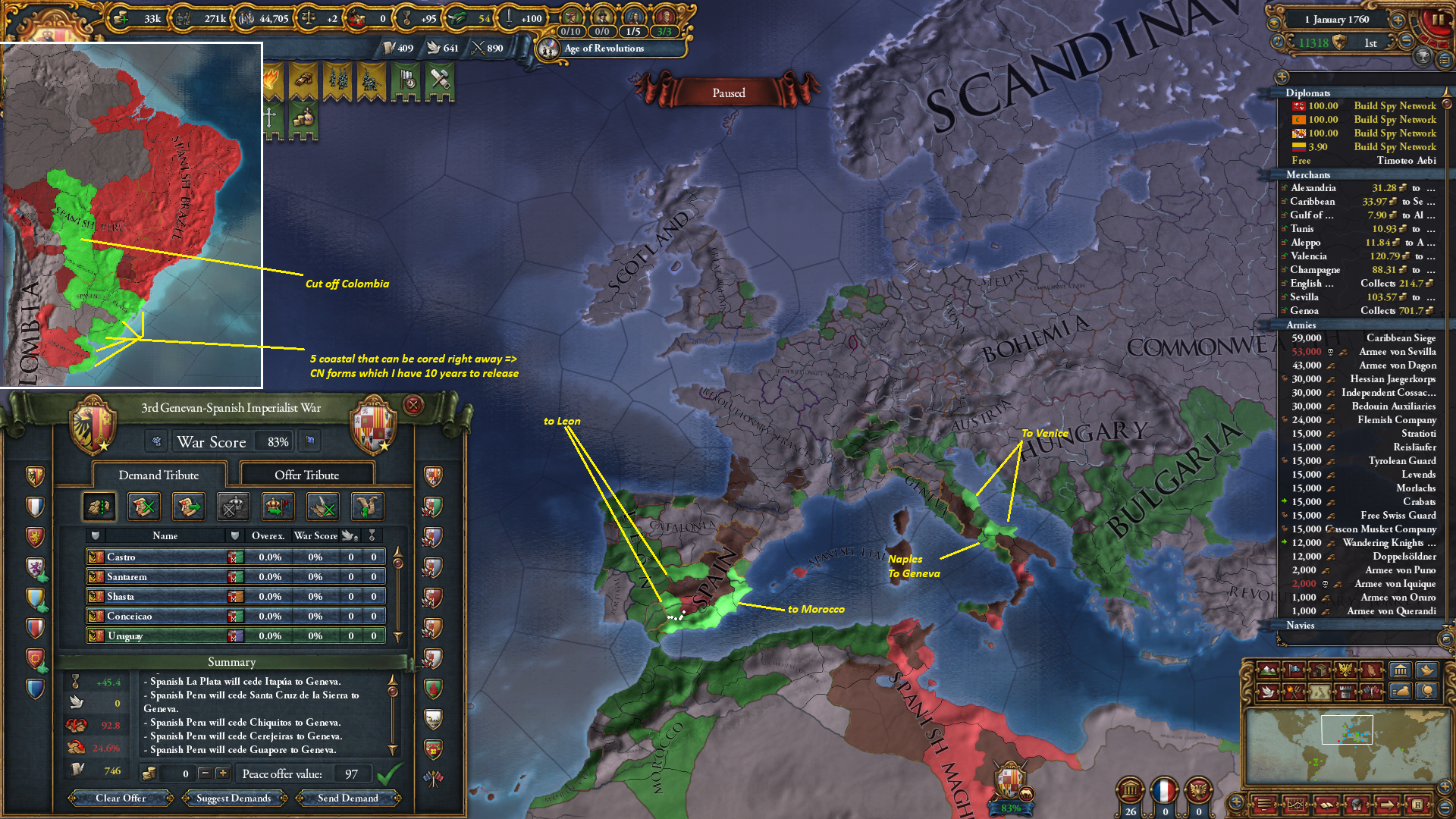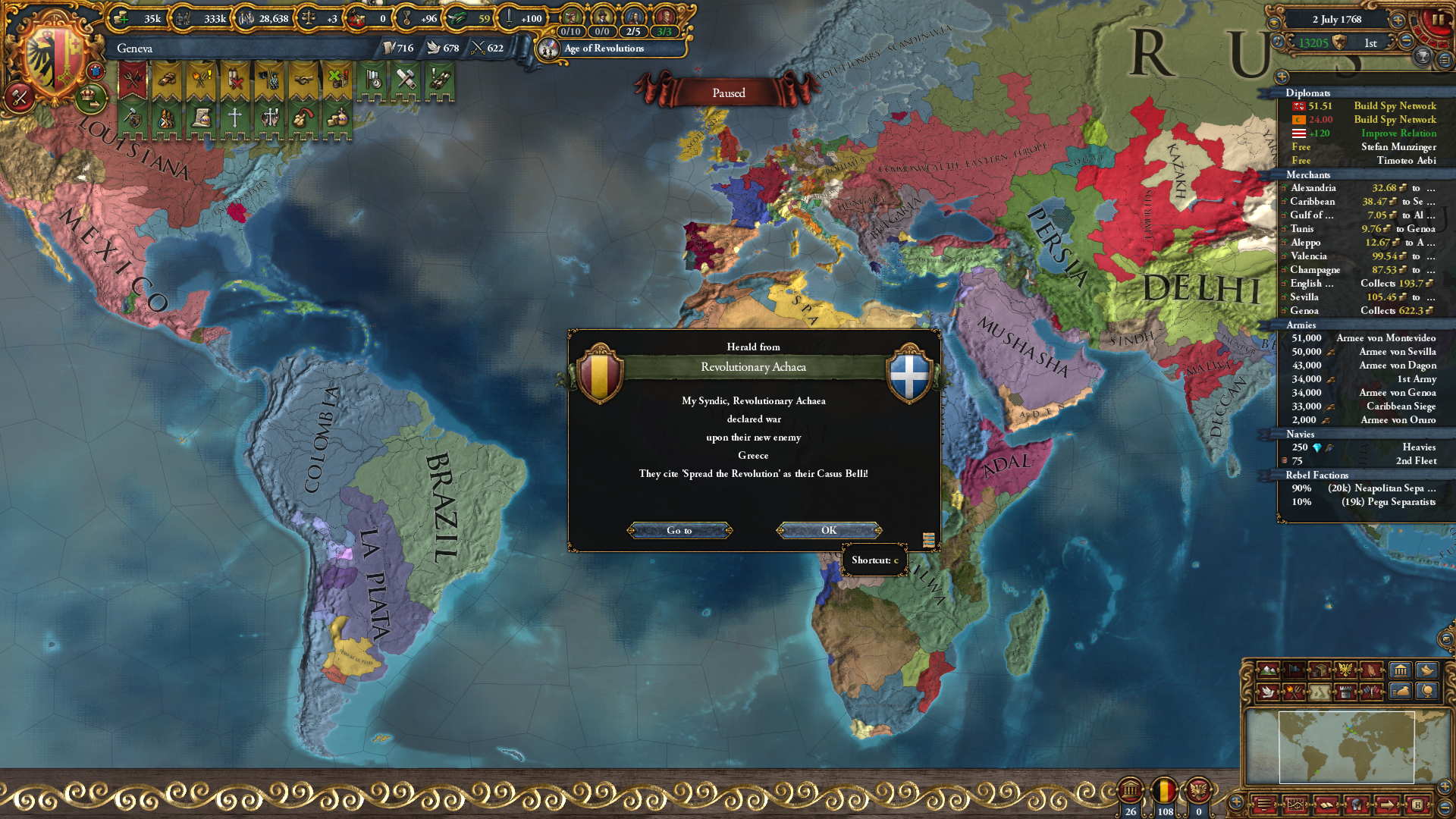Chapter 31 : The Invisible Hegemon ( 1760-1770)
We left the last chapter with Geneva having defeated Spain in war and waiting on the start of the decade to impose peace. That peace was signed in March 1760
Spain had to cede her entire Mediterranean coast to Morocco, and cede her capital of Toledo and the city of Cordoba to Leon. Geneva got two provinces: Terracina and Napoli which were to be the provinces of the decade ( since Geneva did not annex anything in the 1750's , she could take 2 provinces this decade ) . Venice got two provinces And finally, Geneva acquired a swath of land extending from the mouth of the River Plate to the the Amazon . That land would eventually become the colonial nation of Argentine.
The drubbing of Spain meant that Geneva was now the first Great Power . And to put an exclamation point on that fact, Syndic Gasenzer declared Geneva the economic hegemon.
But that caused a souring of relations with Geneva's allies, and Bulgaria threatened to break the alliance. The Syndic considered Bulgaria a key ally , since they could help in a future war against the PLC. So he paid off their debt and worked on keeping them as allies
Alas, keeping Bulgaria as an ally led Venice - Bulgaria's rival - to break the alliance. And Morocco did the same ( possibly because of a clerical error in the peace treaty where Geneva annexed Bizerte which was meant for Morocco, but would later be sold to the Moroccans). In any case, the loss of Morocco and Venice as allies was viewed more with sadness at losing long term friends, rather than alarm at losing important allies. Because Venice and Morocco were mainly useful in beating up Spain. But now Spain had entered the spiral of death.
First Colombia took a chunk out of her holdings in Peru and La Plata . Then Spain got sucked into defending the Meso-American minor of Coixtlahuaca against Mexico. Which prompted a revolt by Brazil, who was now larger than her colonial overlord. Australia would follow suit a few months later.
Spain's troubles meant she was no longer a threat to Geneva's hegemony. Rather, the rising threat to that dominance were the American powers of Mexico and Colombia, allied to each other and poised to gain more land at the expense of Spain. The Syndic felt that this was the time to contain this threat , before Geneva got tied down in a European war ( e.g against the PLC ) . So he took advantage of still having many troops in South America, and began ferrying the rest of the armies to Havana . And once those troops were on the way, he declared war on Mexico
On Mexico's side were her fellow Portuguese culture nations of West indies , Louisiana and Colombia. On Geneva's side was the USA , who was called in with the purpose of receiving land from Mexico , more so than contributing to the war effort.
The war in the Americas had two theatres: in the North, where Geneva had to defend her outpost at Havana and help the USA hold off the MExicans and Louisianans. And in South America, where Geneva's troops in the La Plata region were tasked with attacking Colombia via Peru .
This was for sure not an easy war, as the two sides were evenly matched, and Geneva could not easily reinforce her troops in the Americas except with mercenaries.
The first major engagement happened on the island of Cuba as Genevan armies arriving from Europe lifted the siege of Havana and then chased the West Indians to Camaguey and destroyed them
After that Geneva would occupy the entire island and move her troops to Florida in the USA .
In the South American theatre, Geneva was lucky to hold off an attack by the Colombian vanguard troops at Moxos , a jungle province in the eastern foothills of the Andes . A second battle followed a month later in March 1761 , with a similar brave stand by the mercenaries led by the Swiss Free Guard company .
Those victories allowed the Genevan regular troops to take the fort of Chichas in the Andes, and lay siege to the fort of Tiohuanaco .
Meanwhile on the external front, back to back declarations of war by Portugal and Catalonia put the final nails in the coffin of the Spanish Empire
Back in North America, the dominance of the Genevan fleet meant that Geneva could move her troops easily between Cuba, Florida and the Carolinas. And so she was able to lift the siege of Cusabo - a vassal of the USA - and retake the capital of the USA at Calusa.
Then the Genevans took the offensive and defeated the enemy twice at Ais (East Florida) and again at Sawokli (Florida Panhandle).
Those victories allowed the Genevan armies to form one very large force and sweep around the American South, picking off smaller - but still significant- enemy forces one by one and destroying them
Those total victories were facilitated by sweetened mercenary contracts that improved the discipline of Geneva's mercenary companies, which formed the bulk of her field troops.
Back in South America, things were trickier. There, the Colombians enjoyed a numerical advantage . So the Genevans avoided direct battles, and instead clung to the defensible mountain provinces, allowing the Colombians to invade the upper La Plata basin .
In that endeavor, Geneva had one big advantage in her siege ability . Thanks to significant artillery forces and the military policy and offensive ideas, she was able to secure the mountain forts in the area. And when the Colombians tried to retake the one at Chichas, it ended in a Genevan victory.
Back in the North, the stackwipes of several armies in had allowed Geneva to push into Louisiana and take her poorly fortified capital of Neozho, and to defeat the combined Mexican and Louisianan forces in Ohio.
At that point the USA was completely liberated from enemy occupation and the offensive into enemy territory had begun. That meant the fleet was not needed as much anymore around Florida, and was sent to Europe to pick up 80,000 men recruited in the home provinces . Those men would arrive to Trinidad , the capital of Colombia, as force of 69,000 due to sea attrition. But that was certainly sufficient to put the enemy capital under siege.
Meanwhile in the Andes, Genevan forces reached and took the city of Quito.
There was remarkably little resistance to these attacks by the Colombians, whose main army was in the La Plata region. And a big factor in the lack of resistance was likely the complete depletion of their manpower reserves
With the enemy nations out of manpower, the war became an easy affair for Geneva . And the first enemy to sign peace was Louisiana , who was forced to give up their short coastline to the United States.
Soon after the 5 provinces in the La Plata became cores of Geneva, and the Colonial Nation of Argentine was born as a result.
That nation immediately became part of the ongoing war. And it was immediately given the occupation of all Colombian provinces in the region. Fighting in South America continued for another year, with more victories by Geneva until Colombia was ready to sign peace
In the peace , Argentine received all the provinces bordering the La Plata river that Colombia held, and one of the Andean forts.
That left Mexico as the last enemy standing ( West Indies signed a white peace a few months earlier). And peace was soon concluded
The big winner in the peace was the USA who received Eastern Texas as a reward. And the Syndic was willing to give the USA more land, but they did not want it. And so he forced Mexico to give independence again to the Aztecs and to return a couple of provinces to Spanish California.
With Geneva at peace, the Syndic gave complete independence to Argentine, thus putting Geneva's province count back within the accepted bounds.
And in contrast to previous vassals of Geneva who were granted independence, Argentine - renamed La Plata- maintained good relations with Geneva and soon concluded an alliance with her.
The war in the Americas turned out to be Geneva's last war in our narrative . Because for the remainder of the 1770's , Geneva remained at the top of the Great Power rankings.
And Geneva would remain secure in that perch thanks to the rapid expansion of both Napoli and Terracina to large sizes
And in the case of Terracina, the Genevans reached the Holy Grail of efficient development, with the city expanded at the lowest possible cost. As for Geneva's competitors, the only one that remained within striking distance was the PLC . Spain had fallen off the Great Power table. In fact , Spain was kicked out of Iberia completely by the Catalans, and their capital moved to the Canary Islands.
Soon after, Brazil joined the family of independent nations. And so did the rarely seen nations of Greece and Achaea, who promptly went to war over who is the true Greek .
The decade ended with Gasenzer still at the helm as Syndic. And with Industrialization spawning in Westfalen. But that was not a big concern , as it was bound to soon appear in Geneva .
And we now present the final Status of Geneva map
Geneva is the #1 Great Power . And has plausible means of dealing with any threats. For the PLC, another war with Bulgaria, Scandinavia and Bohemia as allies would take care of it . For Shun, Deccan and Ayutthyaya, Geneva can call on Bengal and Malwa to help contain them. And in the New World, the alliances with United States and La Plata can be used in a repeat of the last war.
Finally we will close with a map of the world. There is a hegemon on this map. But being a very "tall" nation, that hegemon is barely visible.
The End.





















































